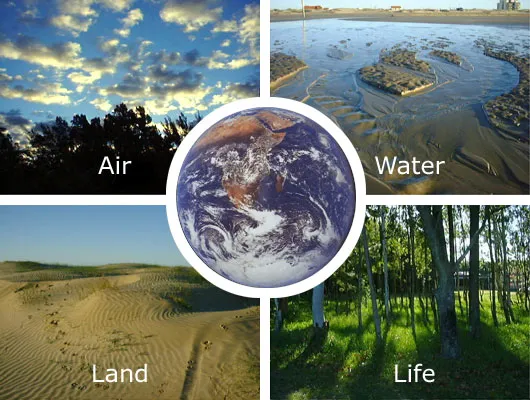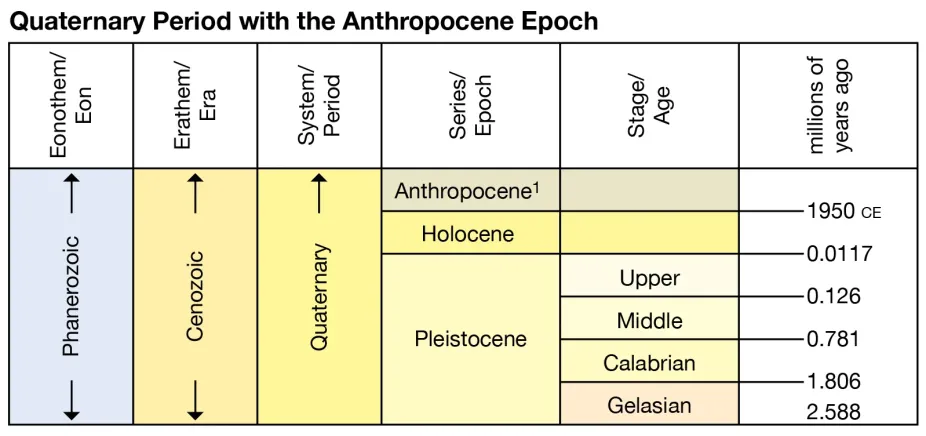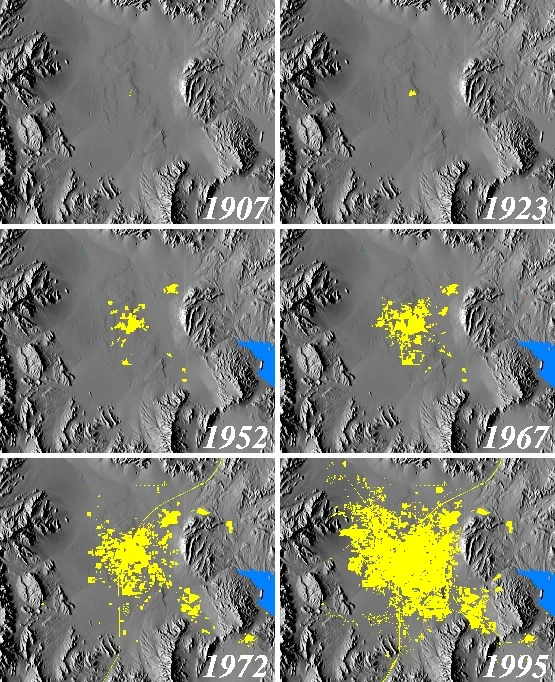Earth System and the Anthropocene
Anthropocene-Earth System Connections
As Earth’s population increases, human impacts on the biosphere, atmosphere, hydrosphere, cryosphere, and even the geosphere also increase. Many of the changes resulting from human activity have already noticeably impacted the planet’s air, water, land, and life.

Earth system science explores the connections between all parts of the planet--the air, water, land, and life. Human activity affects each of these components.
M. Ruzek
What is the Anthropocene?
The term “Anthropocene” is often used to refer to the most recent years in Earth’s current geological epoch -- the time when human activity has been the main influence on Earth’s climate and the environment. Geologically, Earth has been in an epoch called the Holocene for the last ~11,700 years, since the end of the last major ice age. The Anthropocene does not have official worldwide recognition as a separate geologic time within the Holocene, but scientists and others have been increasingly using the term to mark the time period during which human impacts have been both numerous and significant.

The Anthropocene represents the most recent years (from 1950 onward) of the Holocene, Earth’s current geological epoch.
Anthropocene Working Group / ICS
In 2016, the Anthropocene Working Group (part of the International Commission on Stratigraphy) recommended that the “Anthropocene” be made a formal geological epoch, with a 1950 start. Why 1950? This date is consistent with the early detection of impacts from nuclear fallout due to atomic weapons tests. It is also when industrialism and changes in the environment began to increase at a very rapid rate. Human-caused climate change is considered an additional marker of the Anthropocene, though it is not the only distinguishing factor.
Interactions with the Atmosphere
Human activity increases the amount of carbon dioxide and other greenhouse gases in the atmosphere. These gases warm the planet, directly affecting the hydrosphere, cryosphere, and biosphere. Even if the amounts of greenhouse gases are small in proportion to the total atmosphere, their relative increases are significant. The impacts based on these gases’ powerful heat-storing and releasing capabilities are also substantial.

Human activity since the start of the Industrial Revolution has resulted in high levels of carbon dioxide emissions (gray line) from fossil fuel use and increased the amount of carbon dioxide in the atmosphere (blue line) from less than 280 parts per million to over 420 parts per million.
NOAA
Interactions with the Hydrosphere
The hydrosphere -- including freshwater across the continents and the 70% of water in Earth’s ocean -- is essential for life on Earth. The ocean provides an important food source for humans and other species based on its ample fish and marine life. It also helps regulate the climate and generates the oxygen humans breathe. Without Earth’s limited freshwater, agriculture would not be possible, and plants and animals would not be able to survive. But the ocean is being overfished, warming, and becoming more acidic due to human-caused climate change. Freshwater resources are becoming more scarce in parts of the world affected by drought or other weather pattern changes linked to climate change. Many water sources face contamination, pollution, or overuse.
Interactions with the Biosphere
The biosphere encompasses all parts of the Earth occupied by living organisms. These organisms include plants, animals, and bacteria, along with the water and soil where they live. Humans are part of the biosphere and our footprint within it continues to increase. From 2010 to 2022 (a timeframe of just 12 years), the human population increased by a billion people, reaching a new total of 8 billion. The population is expected to reach 10.4 billion by 2100. Humans -- including ourselves -- take up space and consume resources. Clearing forests, extracting and burning fossil fuels, and disposing of or releasing pollutants in the environment (whether on purpose or accidentally) are all examples of human activities that directly change the biosphere. Over the past 200 years, species have been going extinct at an alarming rate. Scientists studying amphibians, reptiles, birds, plants, mollusks, and other life forms have found that about 1% to 2% of species are already extinct today, and 20% to 50% are threatened. Without protection, as many as 75% of today’s animal species could vanish in the next 300 years. As part of the biosphere, humans can take a larger role in its care. Already, there are efforts worldwide to protect wilderness and its inhabitants, encourage sustainable agriculture, promote green spaces within cities, and work toward reducing humans’ overall footprint on our environment.

Humans can help preserve and protect forests and wilderness and promote green spaces and sustainable agriculture.
Creative Commons kazuend
Interactions with the Cryosphere
As humans put more greenhouse gases into the atmosphere and warm the planet, the cryosphere is melting. Ice sheets, glaciers, and permafrost are all losing mass, both at northern latitudes and in the Antarctic. Scientists predict that over the next 80 years, glaciers in the European Alps could experience an 80% loss in ice volume, and those in Asia could shrink by 50%. Many areas, including at midlatitudes, are experiencing reduced snow cover. These changes don’t just affect the cryosphere: less wintertime snow cover at midlatitudes means less available water that will be needed for humans, agriculture, and ecosystems as spring and summer arrive. These changes affect the biosphere through earlier and more severe fire seasons. The effects of cryosphere changes on other parts of the hydrosphere can be significant. As ice sheets and glaciers melt, the water released can result in sea level rise, affecting coastlines around the world. As permafrost melts, it releases stored carbon dioxide into the atmosphere, further increasing warming through a positive feedback loop.
Interactions with the Geosphere
The geosphere includes all the rocks, land, and minerals making up the solid part of Earth. Humans affect the geosphere significantly by flattening mountaintops for development, constructing dams and reservoirs, and extracting materials from within Earth’s crust. Material extraction can be particularly impactful on the environment. The practice of surface mining, for example, displaces rocks and topsoil to extract the materials underneath. These activities might involve scooping gravel or other rock from pits or mining materials that are present at such low concentrations that tons of ore must be processed to get a gram or less of the precious metal. If not remediated or repaired, the scars and disruptions to the landscape can be visible and long-lasting. Extracting materials and altering the geosphere also affects other parts of the Earth system. Humans extract fossil fuels from the geosphere and use these products (oil, coal, petroleum, natural gas) to power our cars and produce electricity. The carbon dioxide and other greenhouse gases released into the atmosphere from burning these fossil fuels contribute to the human-caused warming previously discussed and feed an ongoing cycle of human impacts on the planet.

Land use changes resulting from the growth of the Las Vegas metropolitan area (in yellow) and the creation of the Lake Mead reservoir (blue).
USGS
Science Success Stories
There are many concerns about the impacts of human activities on the Earth system, but success stories also abound. In 1987, every nation in the world agreed to stop the production of harmful chemicals responsible for destroying the layer of ozone in Earth’s stratosphere that protects the planet and its organisms from harmful ultraviolet radiation. Scientists have found that the ozone layer is now healing. In 2019, the phase-out of ozone-destroying chemicals plus favorable upper-atmosphere weather patterns resulted in the smallest ozone hole since 1982. Full recovery is expected around 2040.
Already, bright minds around the world and in all kinds of careers are working on trying to address the challenges of the Anthropocene, including climate change. Humans also take positive actions, including planting trees, recycling, conserving water, improving energy efficiency, enacting pro-environment laws and legislation, and protecting sensitive ecosystems. Through responsible efforts to protect the Earth system, scientists and policymakers alike hope to work to achieve a more sustainable future for our planet.